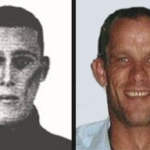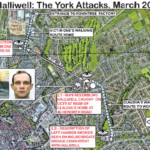Manchester 2: The Murder of Helen Sage – Re-Assessed
by Tim Hicks and Chris Clark
~~~~~
Introduction
The authors have written a series of articles about serial killer Christopher Halliwell entitled “Christopher Halliwell the Secret Murders” in which we examine murders that may have been committed by serial killer Christopher Halliwell, but which remain unsolved or unknown.
Initially there were planned to be four articles, but so much information has emerged that they have now evolved into a mini-series, which is documented at the end of the article.
These articles have the following objectives:
- Generally helping to progress the police investigation into these crimes in the hope that media coverage may generate further information from the public. For this reason we always include an appeal for information in each article.
- Recording the known facts of individual cases and formally indicating Christopher Halliwell as a suspect in them, to assist in identifying all of his potential offending.
- Exposing the systemic failings in the way English and Welsh police forces investigate cross force murders, with the intention of obtaining recognition of this and improvements in this aspect of policing.
Halliwell’s undetected victims fall into six distinct categories:
Murders where the police have a body
1) Murders for which no one has been convicted and which the police have not connected Halliwell to. (e.g. Vicky Glass).
2) Murders where (a) the wrong man has been convicted, or (b) the wrong man has been accused of the murder and the police are not pursuing any other suspects, because of ‘confirmation bias’ in the investigation. (e.g. Ann Heron).
3) Murders where the police have a body, but cannot identify it and have not connected Halliwell to it. (e.g the Angel Meadow murder).
Murders where the body has been concealed and the victim is not reported as missing
1) Murder victims whose bodies have been concealed, but who have not been reported as missing. So consequently the police are genuinely unaware that any crime has taken place. (e.g. Becky Godden-Edwards, who was only known to be missing when the police recovered her body).
Murder victims where the body has been concealed and the victim has been reported as missing. Known as no body murders:
1) Murder victims whose bodies have been concealed, but who have been reported as missing, whom the police are satisfied are murder victims, even though there is no physical evidence of crime (e.g. Claudia Lawrence).
2) Murder victims whose bodies have been concealed, who have been reported as missing, but who the police are treating as missing persons (i.e. still alive), not a “no body” murder victim.
This article focusses on one largely forgotten case that falls into category 6 above, the murder of Helen Sage.
Helen Sage: Background
Briefly, Helen Sage was a prostitute and a single mother who disappeared in Manchester in August 1997. She was devoted to her child and has never been seen or heard from since.
Helen was at one time suspected of being the unidentified Angel Meadow murder victim, but was eliminated from this inquiry, which remains unsolved.
Greater Manchester Police (GMP) has not formally linked her disappearance with murdered prostitute Julie Jones, although it was recognised at the time that there were similarities. Julie Jones was a prostitute and mother of two, whose naked body was found under bushes at Shudehill Manchester, six days after she was reported missing on the 3rd of July 1998. She had suffered crush injuries to her chest.
Initially, the authors investigated her disappearance and those of Georgina Moore and Helen Currie. All three were classified as “missing”. Enquiries with the National Crime Agency by GMP at the authors request revealed that Georgina Moore and Pauline Currie had been traced and there was proof of life.
However, in the case of Helen Sage there was no trace of her and no proof of life has been discovered since her disappearance. This strengthened the author’s belief that she had been murdered.
Why the authors believe Helen Sage’s disappearance should be reclassified as a murder.
- There was no known reason for Helen to disappear.
- She has been missing for many years and no trace has ever been found of her.
- She had no other way of earning money other than being a prostitute, yet has not come to the attention of the police since her disappearance.
- She was a devoted mother and it is highly unusual for mothers to abandon their children. This is normally accepted as one of the key indicators of a no body murder of a woman. As an example, this was the major factor in convincing the jury that the disappearance of Linda Razzell was in fact a no body murder. The Crown put forward the position that she would not have abandoned her children; therefore she must have been abducted and murdered. This was accepted as evidence that she had been murdered and her husband was convicted.
- Helen Sage was a prostitute, an occupation that is more vulnerable and more prone to violence.
- The National Crime Agency has confirmed there is no proof of life.
The authors believe Christopher Halliwell should be considered as a suspect in the murder of Helen Sage for the following reasons:
- Halliwell lived in the Liverpool area and travelled widely. Manchester is about an hour’s drive from Liverpool.
- The Leeds and Liverpool Canal connects to the Bridgewater Canal and then to the Rochdale Canal, which goes into Manchester City Centre and the abduction point for Helen Sage. Halliwell was a narrow boating enthusiast and may have visited Manchester on a narrow boating holiday.
- Halliwell used prostitutes, so may also have been familiar with her abduction point from picking up prostitutes there while visiting, or on a narrowboat holiday.
So Tim wrote formally to GMP in respectful terms, bringing their attention to asking them to review the case and re-classify it from “missing” to “murder”. He also suggested that Christopher Halliwell should be considered as a suspect.
Chief Constable Hopkins’ response.
The GMP response could not have been more unhelpful.
It refused to re-consider its position or review the case. It insisted that Helen Sage was missing -not murdered- on the basis that GMP Policy was to declare a “no body murder” only if there was physical evidence of a crime.

Chief Constable Ian Hopkins
Refusing to follow College of Policing guidance on missing persons
When I challenged this, the GMP Press Office responded:
“we will not be drawn further on this matter.”
In short, GMP followed a rigid policy of withdrawal from contact with the media, because it had been the subject of justifiable media criticism. I am reminded of the remarks of Deputy Chief Constable Gareth Morgan:
“The media also play a vital role in holding the police service to account and in connecting us with the public – this includes highlighting when things may have gone wrong or where policing is under legitimate scrutiny. The relationship should also therefore be challenging and we need to recognise the role the media discharge on behalf of the public in ensuring that we are accountable.
The responsibility to be open, transparent and accountable is part of the Code of Ethics and sits with everybody in policing.
In recent years there has been a perception, rightly or wrongly, that the police have withdrawn and communicate less openly with the media. This does policing a disservice and I am determined that we need to reset the relationship with the media – an appropriate and professional relationship between the police and the media is in the public interest.”
(Deputy Chief Constable (DCC) Gareth Morgan, National Police Chiefs Council Lead for Media Relations)
(My highlighting in bold)
The criteria for declaring a ‘no body’ murder
The nature of sex workers operating practices required that Helen Sage got into a car with an unknown man. This left her vulnerable to abduction and then murder at a remote crime scene before or after intercourse. It is therefore impossible to detect physical evidence of crime at the pick-up point, because there is none. The only event that occurs is a sex worker getting into a client’s car. The crime occurs later in the car or at the place where intercourse occurs.
If the murderer conceals the body skilfully, there will be no evidence of a crime and the victim will remain a missing persons case indefinitely, or until the murderer confesses. In this respect Helen Sage’s case is the same as the disappearance of Becky Godden-Edwards, which was only resolved eight years later when Halliwell led Detective Superintendent Stephen Fulcher to her grave eight years later. There was no physical evidence of crime in that case either.
Clearly the absence of any physical evidence or a crime scene does not rule out the possibility of a “no body” murder. It therefore should not be used as the sole elimination criteria, particularly when the case involves a sex worker.
To challenge the GMP’s position, Tim researched the College of Policing guidance on suspicious disappearances which can be read here.
“All reports of missing people will be subject to review, either because of the passage of time or because new information comes to light.”
Tim then researched other forces to establish what their force policy was and also researched some cases of suspicious disappearances that turned out to be murders. The results were illuminating:
- Police Scotland: Police Scotland has a force policy that permit the reclassification suspicious disappearances as murder without physical evidence:
“every enquiry is unique and assessed on the individual facts of each case, not on a fixed, inflexible set of criteria”.
- North Yorkshire Police: NYP re-classified the Claudia Lawrence disappearance as a murder, even though there was no physical evidence of abduction or a crime
- West Yorkshire Police: Please see this programme on three successful “no body murder” murder investigations, in which West Yorkshire Police started a “no body” murder investigation for missing prostitutes, Susan Rushworth, Shelley Armitage and Suzanne Blamires, which subsequently led to the arrest of Steve Griffiths, the notorious “Crossbow Cannibal” for the three prostitute murders.
- Humberside Police: Please see below this programme on a successful “no body murder” murder investigation, in which Humberside Police started a murder investigation even though there was no evidence of a crime. The investigation subsequently discovered the body.
- South Wales Police: This BBC article covers a murder investigation by SWP, where a man was charged with murder, even though there was no body, on a “No proof of life” basis.
- Suffolk Constabulary: This BBC article concerning a murder investigation by Suffolk Constabulary is the most impressive condemnation of GMP policy. As with Helen Sage, the missing prostitute Amanda Duncan was a devoted mother to her child. The detective leading the cold case investigation into her 1993 disappearance, -which is being treated as a murder despite the fact that there is no physical evidence of crime- stated:
“Police have conducted “proof of life inquiries” and she had never ever appeared on the radar anywhere.”
“She was a very good mother, her children were well dressed, well cared for and to just disappear with a nine-month-old child at home is not really a possibility.“
(My highlighting in bold)
Although Amanda Duncan disappeared occurred twenty six years ago in 1993, (Helen Sage disappeared in 1997) this investigation has generated now information. BBC article here. This demonstrates that it is still possible to progress cold cases despite the passage of time and why it is so important that even now, some attempt is made to investigate Helen Sage’s murder.
Had the above murders occurred in Manchester, they would all have been misclassified as a missing person’s enquiry and they would have gone completely undetected. As Helen Sage’s murder was.
Interestingly, Helen Sage is listed as murdered in the Wikipedia list of murdered sex workers in the United Kingdom.
The authors assert that GMP’s rigid and inflexible adherence to a requirement for physical evidence is perverse and has resulted in a serious crime going undetected. They further assert that the indicators in Helen Sage’s case specified are so strong that every other force in the UK except GMP would have declared Helen’s disappearance as a “no body” murder.
The College of Policing guidelines require that a missing person case is reviewed regularly and in the event of new evidence. The NCAs confirmation of no proof of life and the author’s correspondence indicating that Halliwell should be considered as a suspect for Helen Sage’s murder constituted new evidence and a new line of enquiry, but GMP have chosen to ignore it.
In summary, the only force I can discover that applies the requirement for physical evidence of a crime as the sole requirement to declare a missing person as a “no body” murder is Greater Manchester. I could find no example of any force that only applied the no physical evidence of a crime criteria in designating a no body murder. Every other force I am aware of in the UK follows a more open and sophisticated policy of considering all of the circumstances and designating a disappearance as a murder even if there is no physical evidence of crime, based on:
1) No proof of life.
2) Circumstantial evidence. The key indicator of a murder in the disappearance of a woman being abandonment of children.
This is consistent with the College of Policing best practice, which GMP choose to ignore.
PFCC Baroness Beverley Hughes
Having been stone walled by the Chief Constable and being of a naïve nature, Tim approached the Police Fire and Crime Commissioner (PFCC) for Greater Manchester Baroness Beverley Hughes on the basis that she is the elected official charged with holding the Chief Constable to account for the efficiency of his force.
He raised concerns with Baroness Hughes that:
- It appeared that a murder of a woman in Manchester had been committed and misclassified as a missing person’s case.
- That GMP force policy was inadequate and non-compliant with recommended best practice that all other forces in the UK
Clearly grave allegations that one would expect should cause alarm at the highest levels in policing in Manchester.
Sad to relate Baroness Hughes refused to get involved on the basis that it was an operational matter for the Chief Constable. This is despite the fact that in fact it relates to force policy, efficiency, and the accuracy of the crime figures, which are not operational matters and are within her remit.

Police, Fire & Crime Commissioner Beverley Hughes
Ineffective and unwilling to confront the Chief Constable
The implication of Baroness Hughes response being that a Chief Constable can be as incompetent and intransigent as he likes and a Police Commissioner does not have to do anything about it.
A similar situation arose in North Yorkshire. However, on that occasion PFCC Julia Mulligan took appropriate action. Following public concern over the ability of North Yorkshire Police to respond to grooming gangs following the Rotherham scandal, North Yorkshire’s Police and Crime Commissioner ordered the Chief Constable to conduct a Health Check on force policy and its ability to respond to a similar situation with in its force area. NYP statement here.
Why are Chief Constable Hopkins and Baroness Hughes refusing to review the Helen Sage case, or to reform and modernise the GMPs policy on “no body” murders.
So why are the authors facing a stone wall of indifference from Chief Constable Hopkins and PFCC to this issue in the face of overwhelming evidence that:
- Helen Sage has been murdered.
- In any other force in the UK her disappearance would have been re-classified as a murder.
- The original investigation was bungled.
- GMP is not capable of investigating a no body murder to the higher and more modern standards applied by all other forces.
- GMP is not compliant with best practice and the standards recommended by the College of Policing.
- The GMP crime figures for serious crime have been under recorded.
There are a number of possible reasons:
- There is a natural antagonism between the police and journalists. The NYE articles have been critical of police investigations and the police generally do not appreciate being taken to task, or criticised by journalists. Hence it is to be expected that there will be some degree of bureaucratic intransigence and resistance to admitting that GMP got it wrong.
- No Chief Constable will willingly open up his force to criticism. As an example, look at the resistance the NYE had from North Yorkshire Police before the force would admit to its inexcusable failure to arrest Scarborough Mayor and Conservative Councillor Peter Jaconelli. BBC Report here.
- Should a Chief Constable admit that his force failed to arrest a serial killer, it will open his force up to a furore of criticism for allowing him to go on to commit further murders.
- Halliwell is imprisoned on a full life term, so resolution of historic crimes he may have committed will not improve public safety, (although it will bring closure to the victims). Understandably Chief Constables therefore prefer to focus police resources on addressing current policing priorities, not investigating historic cases.
- Individual police forces, have enormous pride in having a high detection rate for murders. The detection rate for prostitute murders is very low (66%), because they are usually stranger murders and therefore more difficult to solve. Reclassifying missing person’s enquiries as murders will adversely affect individual forces major crime figures. So there is institutional resistance to reclassifying missing person’s enquiries to murders. The most infamous example of this occurred when senior officers from the Metropolitan Police would not allow two missing children that were discovered dead, to be re-classified from a missing person’s enquiry to a murder, because it would lower the clear up rates. (See “Babes in the Wood Video” at 18 minutes). This allowed serial killer Ronald Jebson to go on to brutally murder eight-year-old Rosemarie Papper.
- Helen Sage was a prostitute and it may be that officers from GMP and the PFCC are not very sympathetic to her as a victim.
When Baroness Hughes was appointed as PFCC, Chief Constable Hopkins said:
“Beverley will bring a wealth of experience to what is an important role dealing with many complex and challenging issues. I look forward to her support to policing in Greater Manchester and to working closely with her.”
Could it be that their working relationship is too close and Baroness Hughes is afraid to rock the Chief Constable’s boat?
Surely not.
The wider impact of all the Helen Sage cases
The concern must be that here are many other cases of women like Helen Sage that are officially listed as missing but have in fact been murdered and their bodies successfully concealed.
I remember very well the discovery of nine bodies in a house in Cromwell Street, Gloucester. When asked if he was surprised at the discovery of so many bodies whose murders had gone undetected, Deputy Chief Constable (Retired) John Stalker replied that he was not at all surprised. He then pointed out that there were over 250,000 people listed as missing in the UK that the police had no idea of their whereabouts and that he was only surprised it didn’t happen more often.
On this occasion, the final word goes to Chris:
“In my experience as a retired police intelligence officer with regards to the sudden disappearance of Helen Sage off the face of the earth. Her case and circumstances should be viewed by Greater Manchester Police alongside that of Donna Keogh and Claudia Lawrence whom both Cleveland and North Yorkshire forces are treating as a no body murder. There are other examples from other historical cases namely Suzy Lamplugh from Fulham in London during 1986 and Louise Kay from Beachy Head in Sussex during 1988.”
The implications of Helen Sage’s case for the “Manchester Pusher” canal deaths
According to this documentary, eighty five people have drowned in Manchester’s Canals since 2008. A far higher number than for the similar City of Birmingham which has a much more extensive canal network. In twenty eight cases the coroner was unable to determine the cause of death and recorded an open verdict. This led to speculation that a serial killer dubbed “The Manchester Pusher” was responsible for some of the deaths.
The authors are both highly suspicious of the number of deaths, which seems too high to be explained by misadventure and suicide alone.
For those who think the “The Manchester Pusher” serial killer theory is far-fetched, please remember the case of Kieran Kelly, a serial killer that murdered his victims by pushing them in front of London Underground trains.
In the documentary, GMP Detective Superintendent Pete Marsh rejects the possibility of murder, because there is no physical evidence of crime (22 mins and 30 mins). The same position GMP took in Helen Sage’s case. However in the programme, a Home Office pathologist states:
- “If a body is put into water this destroys forensic evidence”. (6 mins).
- “It is quite possible that a person can be thrown into a canal and drown, without leaving any physical evidence of a crime”. (20 mins).
- “An otherwise fit and well person that is intoxicated can go into cold water, disappear below the surface, drown rapidly and the body may not come up again and disappear”. (24 mins).
So, in summary, if an intoxicated man is thrown into a canal this can very easily result in a “no body murder” with no physical evidence. It must therefore be a concern that there are many other cases in Manchester of:
- People who are missing, but were murdered by being thrown into the canal, but have been wrongly eliminated as murder victims on the basis there is no physical evidence of a crime.
- Some of the cases of open verdicts are murders, where because there is no physical evidence of a crime, the police are not investigating them as murders. Preferring to believe it was misadventure or suicide.
This could mean that the death toll is far higher than the eighty five people mentioned in the program, because many victims are classified as missing when they are in fact dead.
In the documentary Detective Chief Superintendent (Retired) Tony Blockley who has thirty five years’ experience in investigating serious crime and is a former Head of CID for Derbyshire Constabulary carried out an impartial review of three of these cases. He concluded that there was no evidence of a serial killer. However he was highly critical of the GMP investigations into the deaths of David Plunkett, Souvik Pal and Nathan Tomlinson and satisfied that crime could not be ruled out in any of these cases. This contradicts the GMP findings, which has ruled out murder because (as with Helen Sage) there is no physical evidence of crime.
Returning to Helen Sage’s case, this indicates just how unsatisfactory and out of date GMP policy on “no body” murders is. It is incredible GMP has been maintained it for so long.
Appeal for information
Anyone with information on these crimes should contact the GMP Cold Case Review Unit on 0161 856 5961, or anonymously to Crimestoppers on 0800 555 111.
Deputy Chief Constable John Stalker: An appreciation by Tim Hicks
In the article above, Deputy Chief Constable John Stalker is quoted concerning the issue of missing persons that are in fact murder victims.
Deputy Chief Constable John Stalker died last month.

Deputy Chief Constable John Stalker
John Stalker was an enormously influential policeman and a man of absolute integrity. He had been tipped as a future Commissioner of the Metropolitan Police. However his impartial investigation of the “Shoot to Kill” investigation in Northern Ireland, brought his police career to an end, even though he was eventually exonerated of any wrongdoing.
After he left GMP he went on to be a writer and broadcaster skilfully developing a second career and continuing to contribute to policing by commenting on investigations and shaping public opinion on policing.
His obituary in the Guardian can be read here.
For those NYE readers that are police officers and aspire to Chief Officer rank, his bestselling book “Stalker” should be required reading.
The NYE Christopher Halliwell series
If you enjoyed this article, you may want to read the others in the series:
- The breaking of Detective Superintendent Stephen Fulcher. By Tim Hicks
- Book review: “Catching a serial killer” by Stephen Fulcher. By Tim Hicks
- Christopher Halliwell and Peter Sutcliffe compared. By Chris Clark & Tim Hicks
- Christopher Halliwell how many victims? By Chris Clark & Tim Hicks
- Christopher Halliwell: The Secret Murders. By Chris Clark & Tim Hicks. Parts 1 – 16.
(1. Wiltshire Police – 2. North Yorkshire Police and 3. Cleveland Police)
(4. Greater Manchester Police. 5. Greater Manchester Police and Crime Commissioner).
- York: Did Halliwell murder Claudia Lawrence? 1: Operation Cabin Part 1
- York: Did Halliwell murder Claudia Lawrence? 2: Operation Cabin Part 2
- York: Did Halliwell murder Claudia Lawrence? 3: Operation Essence. Part 1
- York: Did Halliwell murder Claudia Lawrence? 4: Operation Essence Part 2
- The Swindon
- InsideOut Who murdered Linda Razzell?
- Scotland 2: Caroline Glachan re-assessed
- Manchester 2: The murder of Helen Sage re-assessed












